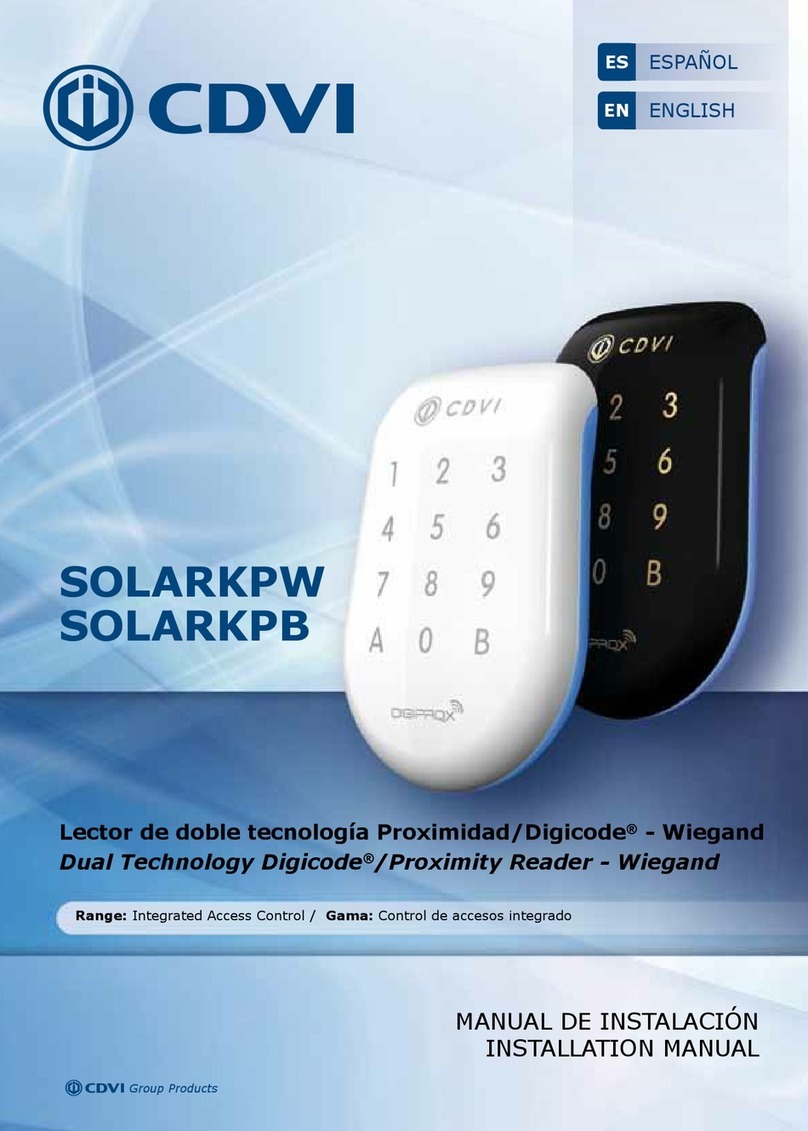
4
Canceling or replacing programmed user codes and badges
Enter the master code twice (for the first use the master code default value is 12345). 2 beeps and the orange LED
light on to confirm that you have entered into the programming mode.
Enter the user number (000 to 499). The LED lights off during 1 second and an audible beep is emitted.
The red LED lights on indicating that the user number is unavailable.
Press the * key twice (**). The LED lights off during 1second and an audible beep is emitted.
The green LED lights on indicating that the user badge/code is cancelled, the user number is now empty.
Press # to exit from the programming mode.
OR
Present the new badge in front of the main reader. Once the audible beep will sound and the green LED will change
to orange then enter a 4-digit code a long beep will sound to confirm that the badge/code has been memorized.
To exit from the programming mode press #. 2 beeps confirm that you have returned to the reading mode.
Reset the master code and the badges
Put the jumper ST1 to position 2-3.
The green LED blinks during 5 seconds. An audible beep confirms that the master code has been
reset to the default value 12345. The red LED blinks.
Take off the jumper from position 2-3 to go back to a normal mode.
OR
Keep the jumper on position 2-3 to reset all the proximity badges.
The red LED blinks during 5 seconds then stays on during the reset.
When the reset is completed the red LED lights off.
Take off the jumper from position 2-3 to go back to a normal mode.
Operating instructions
Mode 00: Present the badge in front of the DGPROXone audible beep will sound to confirm that the badge is valid,
then enter the PIN code.
Mode 01: Present the badge in front of the DGPROX reader or of the second reader.
Mode 02: Present the badge in front of the DGPROX reader, the second reader or enter the PIN code.
After 3 incorrect badge and/or PIN code are entered, the DGPROX reader and the second proximity reader are
locked out during 30 seconds and the alarm relay is activated. 2 audible beeps sound when the badge/PIN code are
not valid.
Alarm function
The tamper switch activates the relay of the alarm when the front panel is removed. If the alarm time delay is
different to 00, the door monitoring (door ajar or door forced open) is enabled:
When the door is opened, without being activated by the request-to-exit button or a badge, the alarm relay is
activated after 1 second and the red LED lights on (forced open door).
When the badge or the request-to-exit button are used to open a door, if the door stays open, the open contact will
trigger the alarm relay according to the door relay output.
Momentary output– the alarm time delay begins at the end of the door time delay. If the door is maintained open
after the alarm time delay, the alarm relay is activated and the red LED lights on. Closing back the door will
deactivate the alarm relay and the LED lights off.
Latched output– the alarm time delay begins only when the door stays open after ordering the closing by presenting
back the badge or pressing on the request-to-exit button, the alarm relay is activated and the red LED lights on.
Closing back the door will deactivate the alarm relay and the LED lights off.
User badges list (Make other copies if needed):






























